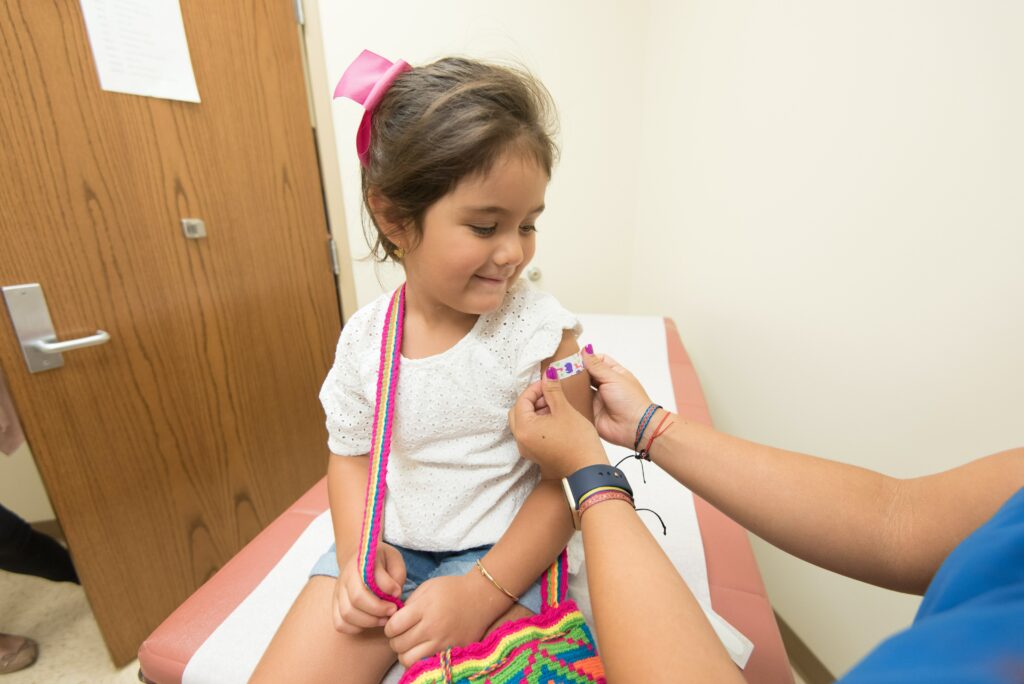A health care worker places a bandage on a child after giving a vaccination shot. (Scott Housley | CDC)
Wisconsin vaccination rates among children entering school are near the bottom of U.S. states, according to a new federal report, and state health officials are amping up public appeals for families to see that their kids are immunized.
“While most Wisconsinites are protecting their children with vaccines, we are below where we need to be to protect our state against preventable outbreaks,” Paula Tran, Wisconsin health officer and administrator for the state Division of Public Health, said Thursday.
The report, published Thursday in the Mortality and Morbidity Weekly Report from the Centers for Disease Control and Prevention (CDC), found that nationally vaccination rates for children entering kindergarten have for four years been below the CDC’s target of 95%. In Wisconsin, however, rates have fallen much lower, to lower than 87%.
Stephanie Schauer, Ph.D., Wisconsin Dept. of Health Services
As a consequence, “Our families and our communities are more vulnerable to diseases like measles,” said Stephanie Schauer, vaccine program manager for the Wisconsin Department of Health Services (DHS) at a media briefing. “These low vaccination rates are worrisome, especially given that there are pockets of the state with very low rates and are not protected against vaccine-preventable diseases.”
The CDC report used data submitted by state health departments, including Wisconsin’s.
One reason for Wisconsin’s lower rates may be the number of families that have asserted exemptions from state vaccine requirements under Wisconsin law.
The report finds that exemptions rose nationwide, with 3.3% of kindergarteners in the 2023-24 school year allowed exemptions from their states’ vaccine requirements.
In 14 states, however, exemptions were applied to more than 5% of pupils. Wisconsin was among those states, with 8% of kindergarteners in the 2023-24 school year allowed an exemption from the requirements.
Schauer said the COVID-19 pandemic was one of several factors contributing to the decline in vaccination rates.
“We know that immunization rates also can be affected by mis- and disinformation,” Schauer said. “We know that there can be access issues in terms of families being able to get to a vaccination clinic or health care provider.”
Trust and confidence in vaccination “has eroded a bit,” she added, “and all of that put together probably is helping to contribute to why we’re seeing this decline.”
Schauer said DHS is working with community groups and tribal communities to cultivate “trusted messengers within a community to talk about vaccines and help build that trust and confidence and increase access to vaccines.”
Vaccines are available from a variety of sources, she said, including local health departments, family health providers, pharmacies and local vaccine events.
Schauer said that for people who are concerned they cannot afford the cost, vaccines are still available at no charge under the federal Vaccines for Children program.
Vaccines for Children serves families with children on Medicaid and who are uninsured or underinsured, including Alaskan natives and American Indian, which includes “about half of the children nationally as well as in Wisconsin,” she said.
Most health care providers who provide child vaccines are part of the program, Schauer added, and families can avail themselves of the service if they inform a provider that they aren’t insured.
The program launched 30 years ago in response to a measles outbreak in the late 1980s and early 1990s, Schauer said. DHS lists participating providers on its website.
“The issue regarding payment should not be part of that decision on whether a child should be vaccinated or not,” Schauer said.
GET THE MORNING HEADLINES.

